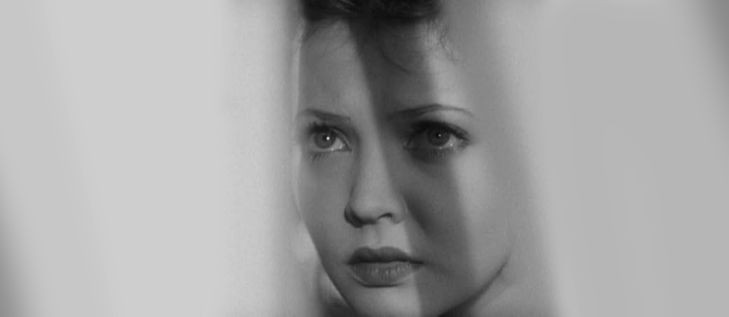Sylvia Sidney pre-Code Classics
The early pre-Code era yields two star vehicles from the dawn of Sylvia Sidney’s long career. In Confessions of a Co-Ed her college girl falls for Phillips Holmes’ thoughtless student and gets herself ‘in a family way.’ In Ladies of the Big House she and her new husband Gene Raymond are framed by a gangster and a corrupt politician. She’s handed a life sentence while he lingers in the Death House. Also along for the ride are future director Norman Foster, Louise Beavers, Wynne Gibson, Jane Darwell and a singing Bing Crosby. Ms. Sidney will forever be the long-suffering Belle of the Depression … she can break hearts with a single close-up.

Sylvia Sidney Pre-Code Classics
Confessions of a Co-Ed, Ladies of the Big House
Blu-ray
KL Studio Classics
1931 / B&W / 1:37 Academy / Street Date August 12, 2025 / Sylvia Sidney pre-Code Classics / available through Kino Lorber / 39.95
Starring: Sylvia Sidney, Phillips Holmes, Gene Raymond, Norman Foster, Wynne Gibson, Claudia Dell, Earle Foxe, Florence Britton, Rockliffe Fellowes, Martha Sleeper, Purnell Pratt, Bing Crosby, Jane Darwell, Bruce Cabot, Louise Beavers.
Directed by David Burton, Dudley Murphy, Marion Gering
 The Sylvia Sidney Pre-Code Classics billboards two 1931 Paramount features that don’t normally come up in discussion of pre-Code cinema. Both star Sylvia Sidney, that amazing actress with the career that flourished for 7 decades, all the way from Reuben Mamoulian’s gangland classic City Streets, to comic roles in Tim Burton comedies.
The Sylvia Sidney Pre-Code Classics billboards two 1931 Paramount features that don’t normally come up in discussion of pre-Code cinema. Both star Sylvia Sidney, that amazing actress with the career that flourished for 7 decades, all the way from Reuben Mamoulian’s gangland classic City Streets, to comic roles in Tim Burton comedies.
Sylvia Sidney soon became identified with socially-progressive films by top directors, what with starring roles in Josef von Sternberg’s An American Tragedy, King Vidor’s Street Scene, Dorothy Arzner’s Merrily We Go to Hell,
William Wyler’s Dead End, and a trio of Fritz Lang thrillers, Fury, You Only Live Once and You and Me. No actress suffered Depression-era injustice more heartbreakingly than did Ms. Sidney, not even runner-up Helen Mack.
Sylvia Sidney carries both pictures with ease; be forewarned that one of the features is much better than the other.
Confessions of a Co-Ed
76 minutes.
Starring: Sylvia Sidney, Phillips Holmes, Norman Foster, Claudia Dell, Florence Britton, Martha Sleeper, Dorothy Libaire, Marguerite Warner, Bruce Coleman, Bing Crosby, Bruce Cabot, Dickie Moore
Cinematography: Lee Garmes
Music Composer: John Leipold
Written by ?
Executive Producers: Jesse L. Lasky, Adolph Zukor
Directed by David Burton & Dudley Murphy

It’s a confession, all right: the film’s opening image is a diary page stating
‘Four years ago I went to college .. an eager freshman. I did not stay. I was not graduated.”
As we’re already primed for naughty & salacious content in pre-Code pictures, Confessions of a Co-Ed promises a lot. It was shot by the fine cameraman Lee Garmes, and avant-garde fans may note that co-director Dudley Murphy was also the co-director of cubist painter Fernand Léger’s classic experimental short subject Ballet Méchanique. Murphy later directed Sylvia Sidney in the ‘Living Newspaper’ social justice movie …one third of a nation…, about dangerously unsafe big-city housing. Confessions begins well, with a distinctive series of push-ins to Patricia Harper writing a diary at her desk at Stafford College. The shot ends with a bravura special effects move through her window, that links to a great shot trucking down a line of pipes in a church’s organ.

Was that stylish opening the contribution of co-director Dudley Murphy? The balance of the film is a by-the-numbers accout of The Way of All Flesh in academia circa 1930. Patricia (Sylvia Sidney) is pursued by two men, the conventional Hal Evans (future director Norman Foster) and the dashing but thoroughly slimy Dan Carter (Phillips Holmes). Dan’s obnoxious attentions woo Patricia away from her studies and his obvious lies somehow defeat her better judgment. Dan and a jealous co-ed Peggy (Claudia Dell) get involved in a car wreck with a cop; she’s thrown out of school but covers for Dan. On a later skiing trip, Dan outright steals Patricia from Hal, and manages to get her alone in the proverbial isolated mountain cabin. Hal later informs on Dan as Peggy’s cohort in delinquency. Dan leaves school and disappears before Patricia can tell him that she’s pregnant.
Confessions is a weak feature with little beyond Sylvia Sidney to reccomend it. Much of the dialogue feels stilted; Claudia Dell and Norman Foster are good on camera but Phillips Holmes is just as unlikable here as he is in pretty much everything we’ve seen him in, including his immediate follow-up with Sidney in An American Tragedy. Some pre-Codes have a reason to include racy subject matter. This script’s leading men are so vapid, Ms. Sidney can’t convince us that her Patricia would fall for Dan. By the time Peggy is talking Patricia into accepting Hal’s marriage proposal, we don’t believe anything we see.

The final act feels artificial, hollow. We jump forward several years, and find that Patricia is Hal’s pampered wife and has a cute boy (unbilled Dickie Moore in his 15th movie). She lives in a penthouse and has servants, which sets aside any thoughts of the Wages of Sin. What will happen when Dan comes back, hoping to re-claim his girl? The dippy non-resolution makes us want to throw things at the screen.
Of special interest are Bing Crosby and The Rhythm Boys, who sing at a formal dance. It’s Bing’s fifth movie appearance in one year, starting with the phenomenal color musical King of Jazz. He doesn’t yet look like much but the magic voice is already there.
Nobody seems to have believed in this one. Confessions of a Co-Ed is noted for having no screenplay or writing credit. The AFI says that the film’s copyright records only cite ‘the diary of an anonymous college girl.’ Contemporary reviews joked that whoever wrote this thing must have wanted to stay anonymous.
Ladies of the Big House
77 minutes.
Starring: Sylvia Sidney, Gene Raymond, Wynne Gibson, Earle Foxe, Rockliffe Fellowes, Purnell Pratt, Louise Beavers, Esther Howard, Jane Darwell, Mary Foy, Theodore von Eltz, Paulette Goddard, Mary Gordon, Roscoe Karns, J. Carroll Naish, Robert Emmett O’Connor, .
Cinematography: David Abel
Music Composer: John Leipold
Scenario by Louis Weitzenkorn additional dialogue William Slavens McNutt, Grover Jones from a play by Ernest Booth
Executive Producers: Jesse L. Lasky, Adolph Zukor
Directed by Marion Gering

The good news is that Ladies of the Big House is a much better picture in all respects. Its story is equally unoriginal, but the production is fine and the well-cast performers seem to believe in the material. Sylvia Sidney has a character she can work with, and an excellent leading man. Although it’s not a musical, the show could have been the subject of Harry Warren and Al Dubin’s satirical lyrics for the song ‘Dames’:
No one cares, and no one knows.
Who is the handsome hero / some villain always frames?
Who cares if there’s a plot or not, when they’ve got a lot of dames!”
Ladies of the Big House is an embryonic Women-in-Prison epic clearly produced in the wake of MGM’s smash hit The Big House from the year before. It grabs us from the beginning, showing that the city’s Assistant District Attorney John Hartman (Purnell Pratt) is a corrupt cohort of gangster Kid Athens (Earle Foxe). Athens has gone crazy for flower shop clerk Kathleen Storm (Sylvia Sidney); when she tells him to leave her alone, he responds with threats. Kathleen meets oil engineer Standish McNeil (Gene Raymond), who turns out to be ‘the handsome hero that some villain always frames.’ On their wedding day Athens kills a cop and pins the crime on the innocent couple. The rushed trial results in a death sentence for Standish and life imprisonment for Kathleen.

Kathleen’s fellow inmates are an interesting bunch, starting with Susie Thompson (Wynne Gibson) a previous flame of Athens, who has it in for her successor. Convicted murderess Ivory (Louise Beavers) befriends Kathleen, while the pregnant Maria (Miriam Goldina) plans a prison break so her baby won’t be born behind bars. Among the cold and hostile staff is a friendly matron, Mrs. Turner (Jane Darwell).
The newlyweds’ appeal is quashed by the crooks in the state capital, but the corrupt chicanery doesn’t let up. On the eve of Standish’s execution, he and Kathleen are allowed to meet against the rules. But they’re pulled apart as soon as a clandestine photo is taken: it’s all a trick to discredit the warden. A detail in a newspaper photo of the ‘Death Row Embrace’ convinces Susie Thompson that Kathleen is innocent, but it is Hartman who hears Kathleen’s plea that the execution be halted. The only way she can get the truth out, is to join Maria in a desperate prison break.
Fine direction and good performances put this standard ‘meller’ way over the top. Ladies of the Big House grabs us from the moment we see Sylvia Sydney’s face. Her character makes sense, even when she and her beau are victimized by such a dubious conspiracy-conviction. We get behind the film’s emotional push: Standish preps for the hangman’s noose with more dignity than did Sidney Carlton. The entire women’s cell block is soon on Kathleen’s side, including her romantic rival, Susie.

Sylvia Sidney’s star power shines in this one. When Kathleen smiles in the flower shop, our enchantment is total. Her unhappy face compels an emotional reaction, overriding the predictable storytelling. Second-billed, in his second movie, Gene Raymond has perfect collegiate good looks and a strong, if slightly passive screen presence. He’d be the leading man for a score of actress’s vehicles, notably Joan Crawford & Bette Davis. Raymond was a loving and loyal husband to Jeanette MacDonald; film noir aficionados admire his late-career starring role in Hubert Cornfield’s eccentric heist film, Plunder Road.
We like Louise Beavers’ contribution, as well as that of favored floozie Esther Howard. In line for the Death Row noose before Standish is Roscoe Karns. He was soon to be a familiar face in ’30s pictures, especially the screwball comedies of Howard Hawks. Karns goes unbilled, which had to have been a mistake. It’s a featured role and he’d been in pictures since 1915.
The movie doesn’t go in for cheap pre-Code thrills, such as the two or three Leg Art close-ups in Confessions. The storyline admits that gross injustices happen, but they’re always because of individual bad-egg miscreants in the system: corrupt DAs, crooked prison workers, ambitious state politicos. Our institutions are sound, as evinced by the good warden, matron Turner, etc.. By contrast, some of Sylvia Sidney’s later pictures are based on the notion that ‘the system’ itself is rotten, and needs to be reformed.
The KL Studio Classics Blu-ray of Sylvia Sidney Pre-Code Classics places two features on a single Blu-ray. Both are listed as remastered from 4K scans. We get new color Universal logos followed by pristine original Paramount logos as they looked in 1931, the first year that the talkies had the technical issues of talking pictures under control. Both movies have survived in excellent condition.
The extras are 5 trailers and a pair of David Del Valle commentaries. He’s accompanied by a pre-Code specialist Stan Shaffer. Mr. Del Valle quotes Sylvia Sidney’s brief remark on the way her film roles concentrate on women’s woes: “I’m paid by the teardrop.”
Reviewed by Glenn Erickson

Sylvia Sidney Pre-Code Classics
Blu-ray rates:
Movies: Confession: Fair; Ladies: Excellent
Video: Excellent
Sound: Excellent
Supplements:
An audio commentary for each feature with David Del Valle and Stan Shaffer
Trailers.
Deaf and Hearing-impaired Friendly? YES; Subtitles: English (feature only)
Packaging: One Blu-ray in Keep case
Reviewed: August 17, 2025
(7379sidn)
Visit CineSavant’s Main Column Page
Glenn Erickson answers most reader mail: cinesavant@gmail.com
Text © Copyright 2025 Glenn Erickson






